Complete Solutions to Exercise of chapter ALDOL AND CANNIZARO REACTION of Class 12 book with complete answers and questions
| Class 12 | CHEMISTRY |
| Chapter | ALDOL AND CANNIZARO REACTION |
| MS CHOUHAN | Exercise |
| Number Of Questions | 56 |
| Academic Year | 2023-24 |
Compound A and B, both were treated with `NaOH`, producing a single compound C.
 Compound C is:04:24View Solution
Compound C is:04:24View Solution
this conversion can be achieved by:06:00View Solution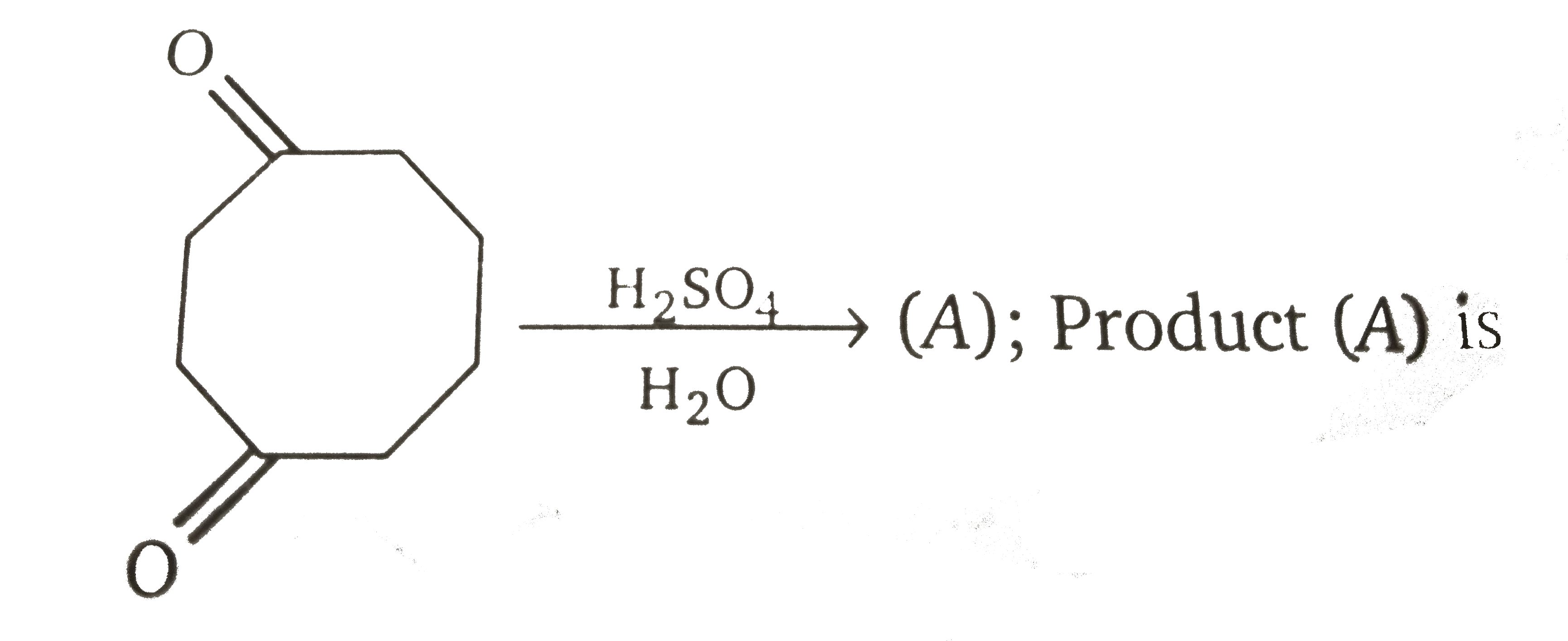
This is an example of an interamolecular aldol reaction:
Product (A) is:07:07View Solution`CH_(3)-overset(O)overset(||)(C)-CH_(2)-CH_(2)-CH_(2)-CH_(2)-CH_(2)-overset(O)overset(||)(C)-Hoverset(HO^(-)//Delta)tounderset((73%))(A)`, product (A) is:
04:19View Solution`Ph-CH=CHCHO+CH_(3)CH=CHCHOunderset(EtOH,Delta)overset(base)to(A)87%`, product of this reaction is:
03:14View Solution`CH_(3)CHOunderset(5^(@)C)overset(10%NaOH)tounderset(Delta)tounderset(Ni)overset(H_(2))to(A):` product (A) of the reaction is,
04:05View Solution Reactant (A) is,04:06View Solution
Reactant (A) is,04:06View Solution`CH_(3)-overset(O)overset(||)(C)-CH_(2)-underset(CH_(3))underset(|)overset(CH_(3))overset(|)(C)-CHOoverset(KOH,H_(2)O)to(A)`, product A is
04:30View Solution product (A) is 01:59View Solution
product (A) is 01:59View Solutionthe reaction
 `NaOHoverset (heat)to`, products identify the product.03:25View Solution
`NaOHoverset (heat)to`, products identify the product.03:25View Solution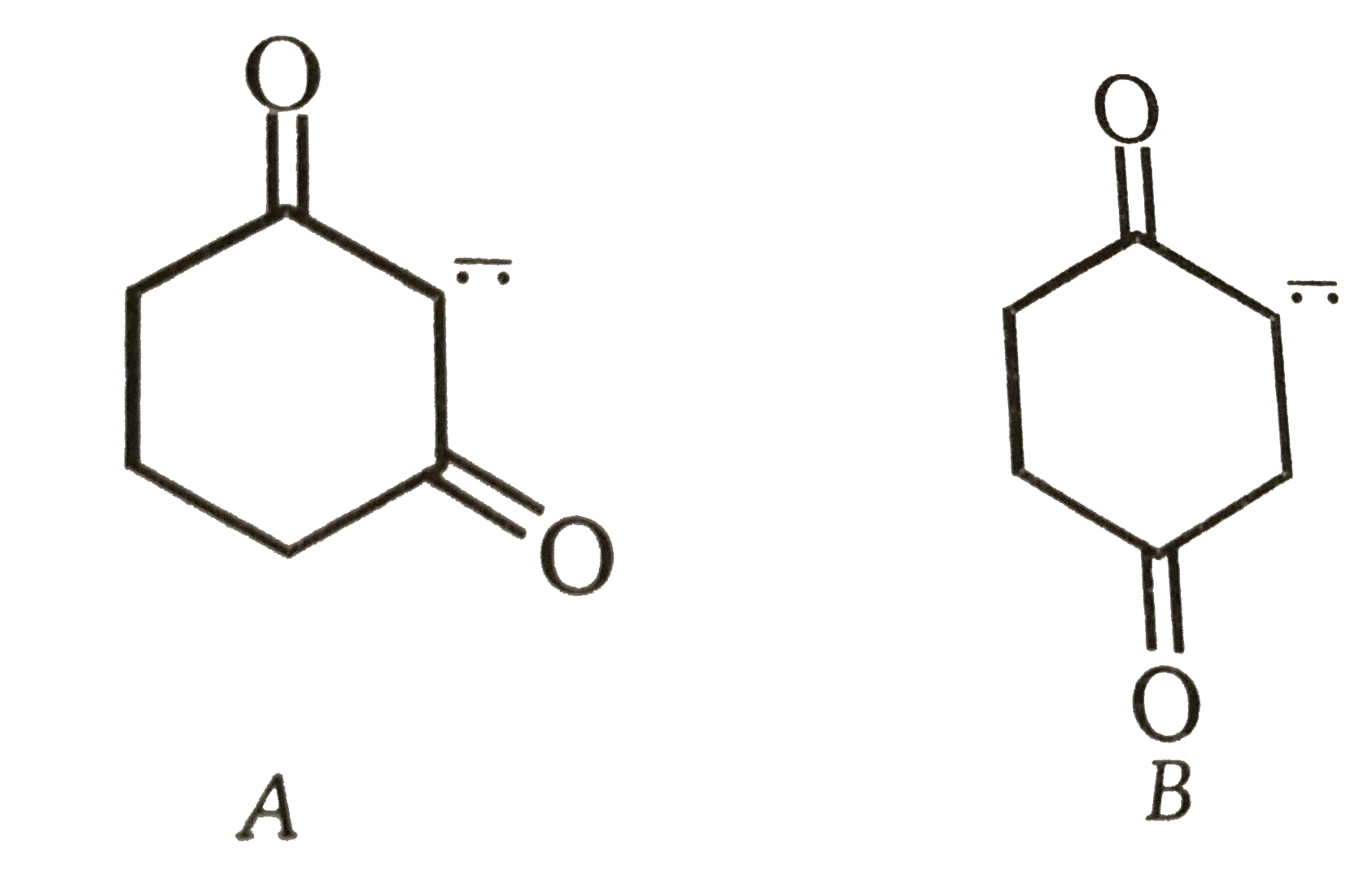
Compare enolate A with enolate B.
Which of the following statements is true?03:42View SolutionBenzalacetone is the product of mixed aldol condensation between benzaldehyde `(C_(6)H_(5)CH=O) ` and acetone `[(CH_(3))_(2)C=O]` What is its structure.?
03:21View SolutionIdentify the major product P in the following reaction:
 04:52View Solution
04:52View Solution
Product (B) is03:32View Solution
Identify the major product P in the following reaction:04:36View Solution
The enolate ion that reacts with 3-buten-2-one to form (Y) is:05:52View Solution
Product (B) in the above reaction is :04:15View Solution`H-overset(O)overset(||)(C)-Dunderset((50%))overset(HO^(-))to` product of this cannizaro reaction is
02:13View SolutionAn organic commpound with the jmolecular formula `C_(9)H_(10)O` forms a 2,4-DNP derivative, reduces tollen's reagent and undergoes cannizaro reaction, on vigorous oxidation it gives 1,2-benzenedicarboxylic acid. Structure of organic compound is:
04:07View Solution`H-overset(O)overset(||)(C)-Doverset(H^(18)O)toD-overset(O)overset(||)(C).^(18)C^(-)+CH_(2)D-OH`
Above reaction is known as,01:24View Solution product (A) is,04:59View Solution
product (A) is,04:59View Solution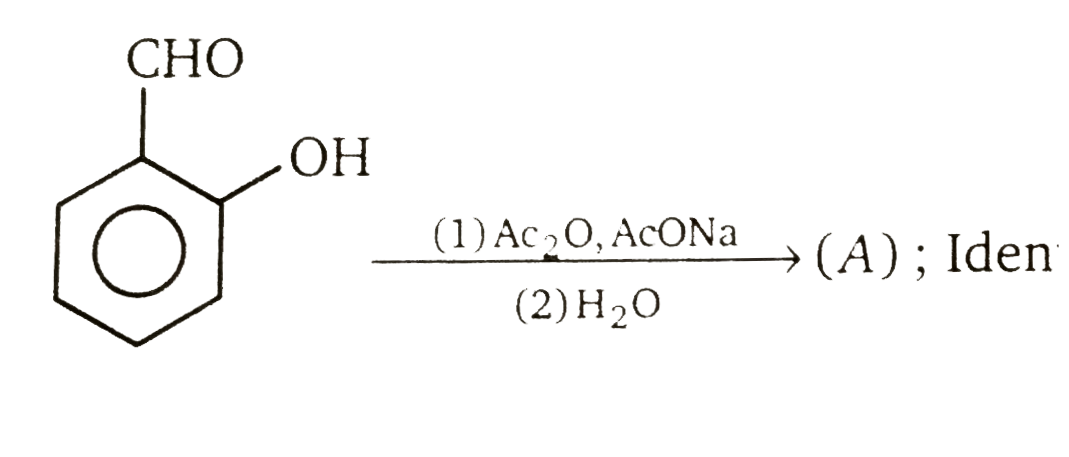 Identify product and name of reaction.01:45View Solution
Identify product and name of reaction.01:45View Solution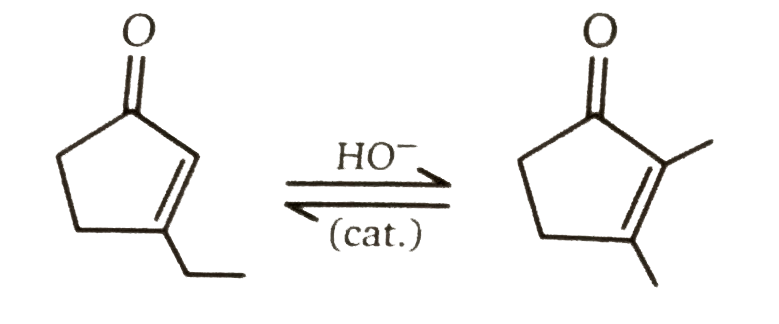
Choose the most reasonable reaction intermediate for the following reaction.04:10View Solution`CH_(3)-overset(OH)overset(|)(C)H-CH_(2)-overset(O)overset(||)(C)-Hunderset(("Reduction aldol"))overset(HO^(-))to(A),3HCHO+Aunderset(40^(@)C)overset(Na_(2)CO_(3))tounderset((82%))(B)`
Product (B) of the above reaction is:03:49View Solution`CH_(3)CH=CHCHOunderset("Aldol condensation")overset(OH^(-))to overset(Delta)to` Product A is
03:49View Solution (A) and (B) are isomer Identify (B).02:45View Solution
(A) and (B) are isomer Identify (B).02:45View Solution product (C) is:02:03View Solution
product (C) is:02:03View Solution
Product (A) is:04:39View SolutionWhich of the following reactant on reaction with conc. NaOH followed by acidication gives the following lactone as the product?
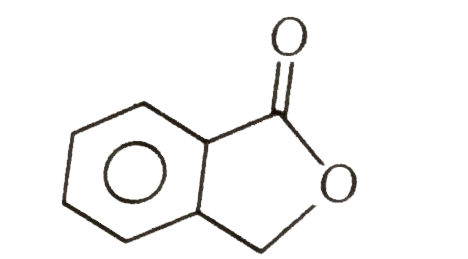 04:52View Solution
04:52View Solution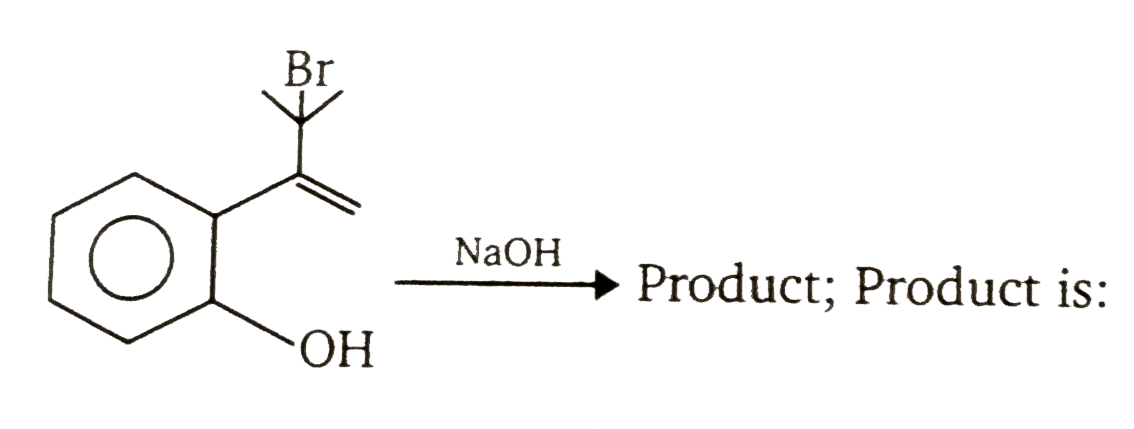 Product is:03:41View Solution
Product is:03:41View Solution 07:23View Solution
07:23View Solution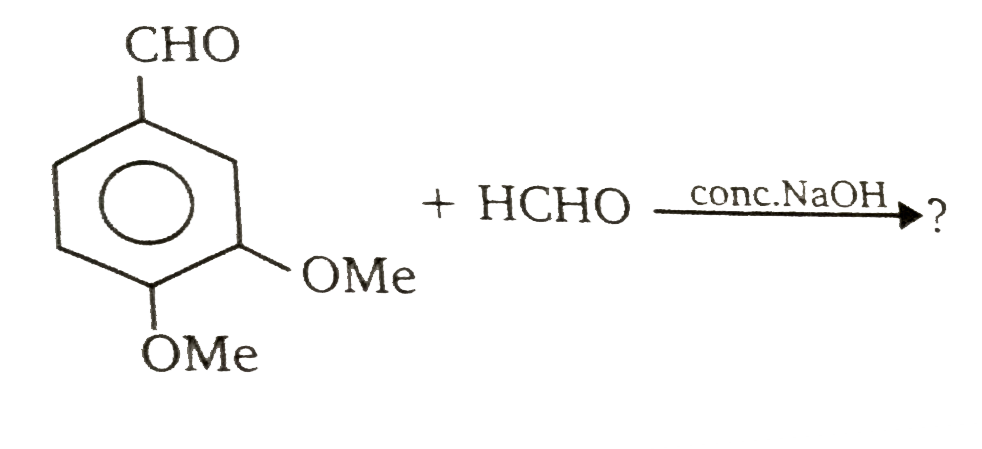
The following reaction gives:03:29View SolutionWhich of the following is not the product of an intramolecular aldol condensation?
03:09View SolutionChoose the reactant whose aldol reaction would give jasmone.
 04:29View Solution
04:29View Solution
Compound X undergoes the following reaction sequence. What is the structure of compound X?03:17View Solution
Predict the major product of the following reaction sequence.04:42View Solution
Structure of (B) is:04:39View SolutionWhich of the following is not the product of an intramolecular aldol condensation?
03:09View Solution
Compound (X) is obtianed by which of the following reaction?03:56View SolutionMechanism of cannizzaros reaction of benzaldehyde is

Q. Which of the following reactants can undergo cannizaro's reaction?03:28View SolutionMechanism of cannizzaros reaction of benzaldehyde is

Q. Order of the above reaction is02:28View SolutionMechanism of cannizzaros reaction of benzaldehyde is

Q. Which of the following is best hydride donor in cannizaro's reaction?03:08View SolutionMechanism of cannizzaros reaction of benzaldehyde is

Q. Cannizaro's reaction is02:07View SolutionMechanism of cannizzaros reaction of benzaldehyde is

Q. Which of the following cannot undergo intramolecular cannizaro's reaction?04:19View SolutionAldol condensation proceeds by carbon-carbon bond formation between an enolate donor and a carbonyl acceptor. For each of the following aldol products (a thorugh e) select a donor and an acceptor compound from the list at the bottom of the page (compounds A through H). write the letter corresponding to your selection in the appropriate answer box.
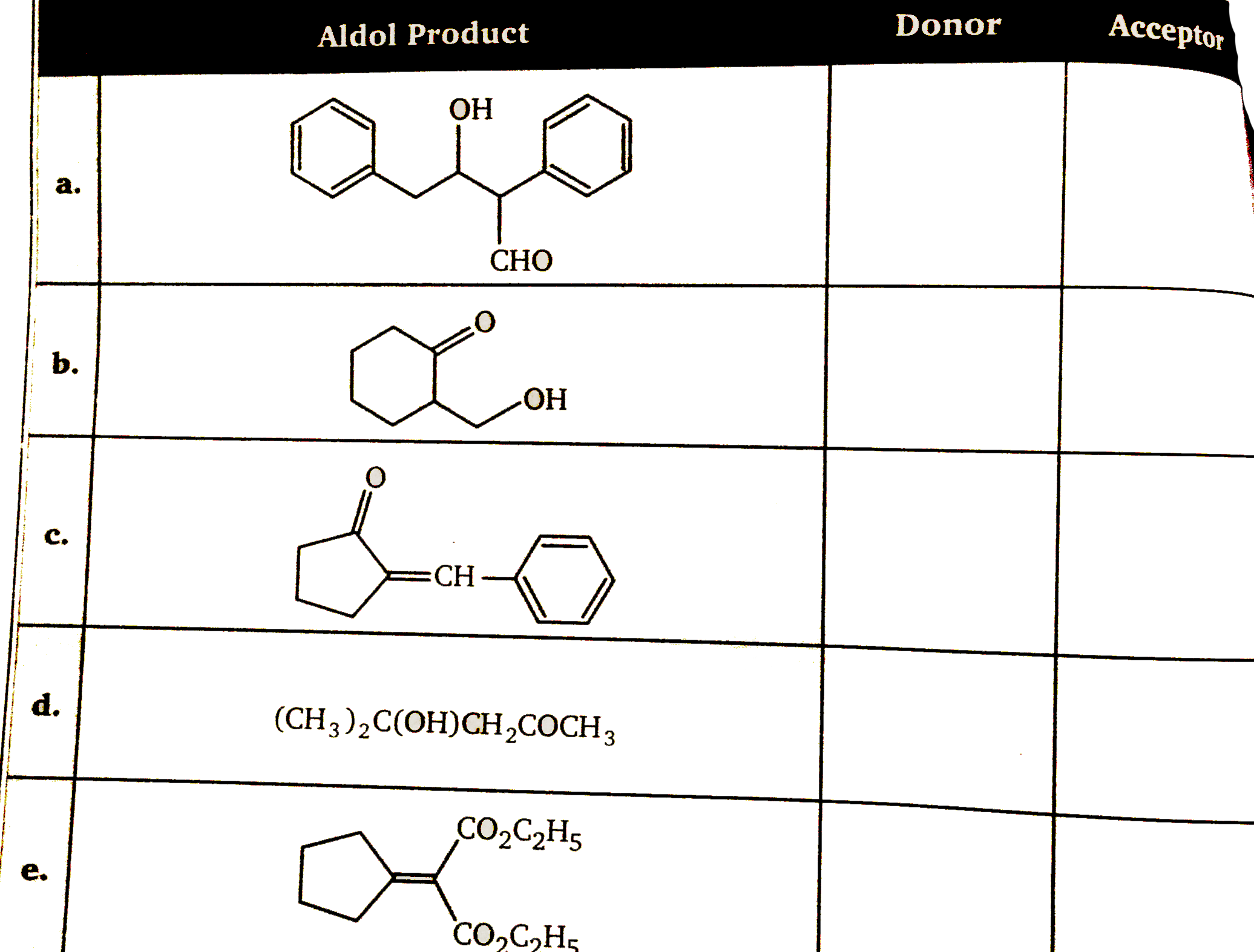 .
.
Q. 05:50View Solution
05:50View SolutionAldol condensation proceeds by carbon-carbon bond formation between an enolate donor and a carbonyl acceptor. For each of the following aldol products (a thorugh e) select a donor and an acceptor compound from the list at the bottom of the page (compounds A through H). write the letter corresponding to your selection in the appropriate answer box.
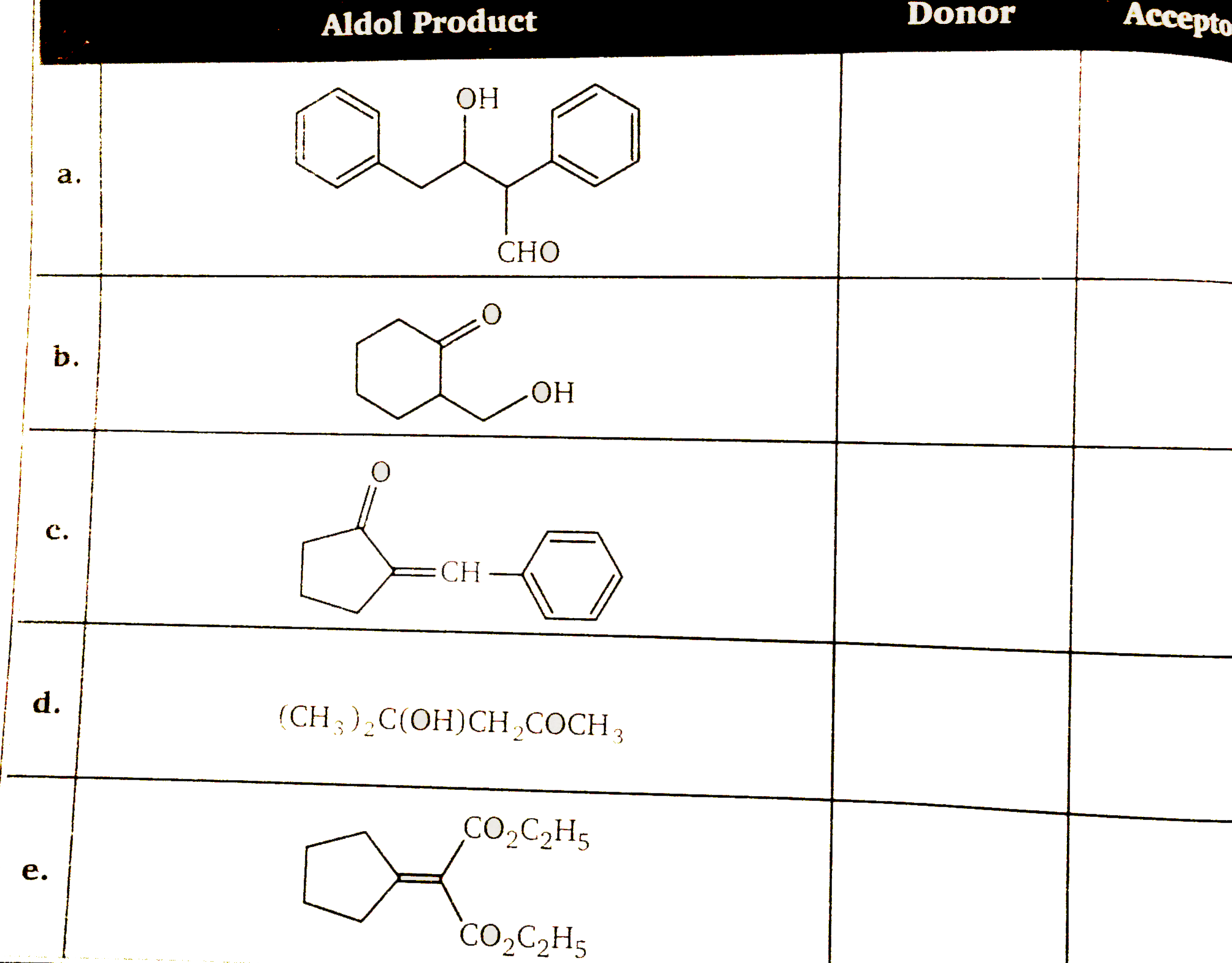 .
.
Q. 05:50View Solution
05:50View SolutionDuring an experimental workup procedure, a chemist treated a starting material with NaoH in the solvent acetone `[(CH_(3))_(2)C=O]`, however, the starting material was recovered unreacted. Instead, the chemist isolated a small amount of product A (shown below).
Product A
1. Elemental analysis of product A indicated that it consisted only of carbon, hydrogen, and oxygen.
2. Product A had a molecular weight of 116 g/mol.
3. Product A was a methyl ketone because it gave a positive iodoform test.
4. When product A was treated with `Br_(2)` in `C Cl_(4)`, the red bromine colour persisted, because no carbon-carbon double bonds were present to react with the bromine.
The structure of product A was further confirmed when treatment with hot sulfuric acid resulted in the corresponding dehydration product, product (B)gt
Q. What is the molecular weight of a compound that undergoes an aldol self-condensation reaction to result in a `beta`-hydroxy ketone with a molecular weight of 144?10:28View SolutionDuring an experimental workup procedure, a chemist treated a starting material with NaoH in the solvent acetone `[(CH_(3))_(2)C=O]`, however, the starting material was recovered unreacted. Instead, the chemist isolated a small amount of product A (shown below).
Product A
1. Elemental analysis of product A indicated that it consisted only of carbon, hydrogen, and oxygen.
2. Product A had a molecular weight of 116 g/mol.
3. Product A was a methyl ketone because it gave a positive iodoform test.
4. When product A was treated with `Br_(2)` in `C Cl_(4)`, the red bromine colour persisted, because no carbon-carbon double bonds were present to react with the bromine.
The structure of product A was further confirmed when treatment with hot sulfuric acid resulted in the corresponding dehydration product, product (B)gt
Q. The aldol self-condensation of acetone is an equilibrium that favours acetone over its condensation product. which of the following experimental modifications is most likely to shift the position of equilibrium towards product A?10:28View SolutionDuring an experimental workup procedure, a chemist treated a starting material with NaoH in the solvent acetone `[(CH_(3))_(2)C=O]`, however, the starting material was recovered unreacted. Instead, the chemist isolated a small amount of product A (shown below).
Product A
1. Elemental analysis of product A indicated that it consisted only of carbon, hydrogen, and oxygen.
2. Product A had a molecular weight of 116 g/mol.
3. Product A was a methyl ketone because it gave a positive iodoform test.
4. When product A was treated with `Br_(2)` in `C Cl_(4)`, the red bromine colour persisted, because no carbon-carbon double bonds were present to react with the bromine.
The structure of product A was further confirmed when treatment with hot sulfuric acid resulted in the corresponding dehydration product, product (B)gt
Q. Based only on observation 1 and 2, which of the following compounds could have been product A?10:28View SolutionDuring an experimental workup procedure, a chemist treated a starting material with NaoH in the solvent acetone `[(CH_(3))_(2)C=O]`, however, the starting material was recovered unreacted. Instead, the chemist isolated a small amount of product A (shown below).
Product A
1. Elemental analysis of product A indicated that it consisted only of carbon, hydrogen, and oxygen.
2. Product A had a molecular weight of 116 g/mol.
3. Product A was a methyl ketone because it gave a positive iodoform test.
4. When product A was treated with `Br_(2)` in `C Cl_(4)`, the red bromine colour persisted, because no carbon-carbon double bonds were present to react with the bromine.
The structure of product A was further confirmed when treatment with hot sulfuric acid resulted in the corresponding dehydration product, product (B).
Q. When a drop of `Br_(2)` in `C Cl_(4)` is added to product B, the resulting solution will ew10:28View SolutionDuring an experimental workup procedure, a chemist treated a starting material with NaoH in the solvent acetone `[(CH_(3))_(2)C=O]`, however, the starting material was recovered unreacted. Instead, the chemist isolated a small amount of product A (shown below).
Product A
1. Elemental analysis of product A indicated that it consisted only of carbon, hydrogen, and oxygen.
2. Product A had a molecular weight of 116 g/mol.
3. Product A was a methyl ketone because it gave a positive iodoform test.
4. When product A was treated with `Br_(2)` in `C Cl_(4)`, the red bromine colour persisted, because no carbon-carbon double bonds were present to react with the bromine.
The structure of product A was further confirmed when treatment with hot sulfuric acid resulted in the corresponding dehydration product, product (B)gt
Q. Wihch of the following compounds from the passage will give a positive iodoform test.?10:28View Solution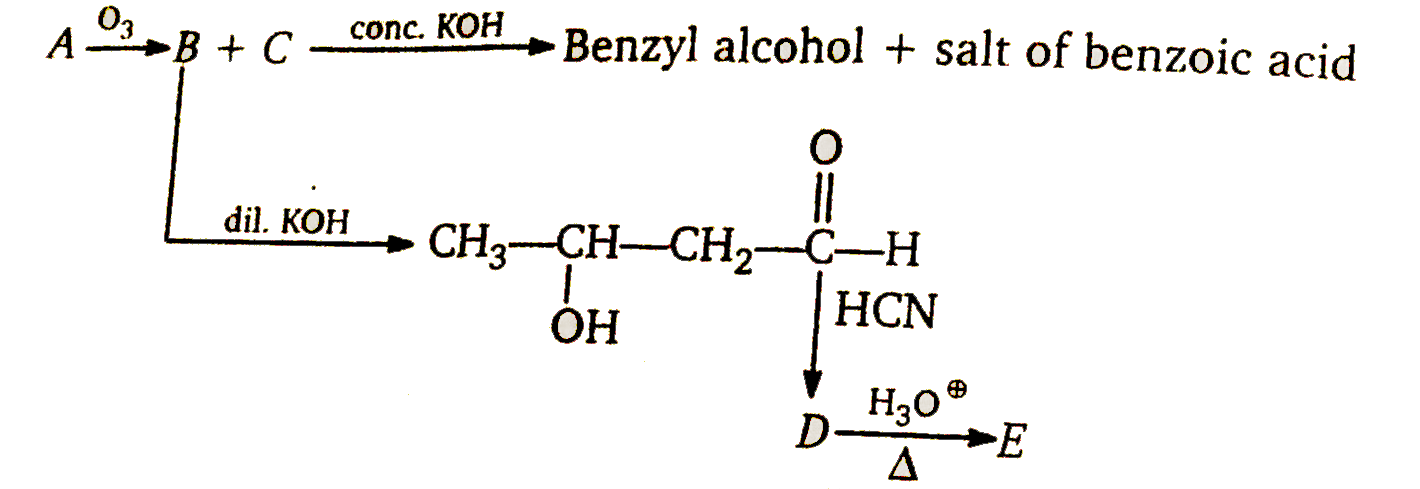
Q. Structure of A is:06:23View Solution
Q. Structure of (B) and (C) differentiated By,12:20View SolutionAn organic compound 'P' with jmolecular formula `C_(8)H_(8)O` forms an organic red ppt with `2,4-DNP` gives yellow ppt. on heating with `I_(2)` in presence of `NaOH`. It neither reduces tollen's or fehling reagent nor does it decolourise `Br_(2)` water or baeyer's reagent. On drastic oxidation with chromic acid `(H_(2)CrO_(4))` it gives an acid (Q) having molecular formula `C_(7)H_(6)O_(2)`.
Q. Identify compound P:13:17View SolutionAn organic compound 'P' with jmolecular formula `C_(8)H_(8)O` forms an organic red ppt with `2,4-DNP` gives yellow ppt. on heating with `I_(2)` in presence of `NaOH`. It neither reduces tollen's or fehling reagent nor does it decolourise `Br_(2)` water or baeyer's reagent. On drastic oxidation with chromic acid `(H_(2)CrO_(4))` it gives an acid (Q) having molecular formula `C_(7)H_(6)O_(2)`.
Q. `Qoverset(NaOH//CaO //Delta)toR` (Major product).
R will be,13:17View SolutionAn organic compound 'P' with jmolecular formula `C_(8)H_(8)O` forms an organic red ppt with `2,4-DNP` gives yellow ppt. on heating with `I_(2)` in presence of `NaOH`. It neither reduces tollen's or fehling reagent nor does it decolourise `Br_(2)` water or baeyer's reagent. On drastic oxidation with chromic acid `(H_(2)CrO_(4))` it gives an acid (Q) having molecular formula `C_(7)H_(6)O_(2)`.
Q. `Punderset(Delta)overset(dil.overset(ө)(O)H)toSunderset(H_(3)O^(o+))overset(CH_(3)MgBr(1" mole"))to`
No. of stereoisomer in the final product T:13:17View Solution
Exercise questions and complete solutions for chapter ALDOL AND CANNIZARO REACTION of MS CHOUHAN CHEMISTRY (HINGLISH) of Class 12
